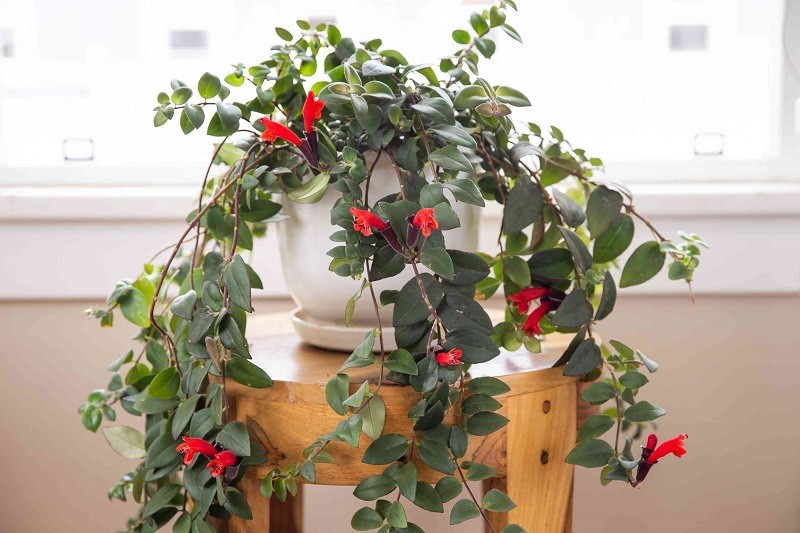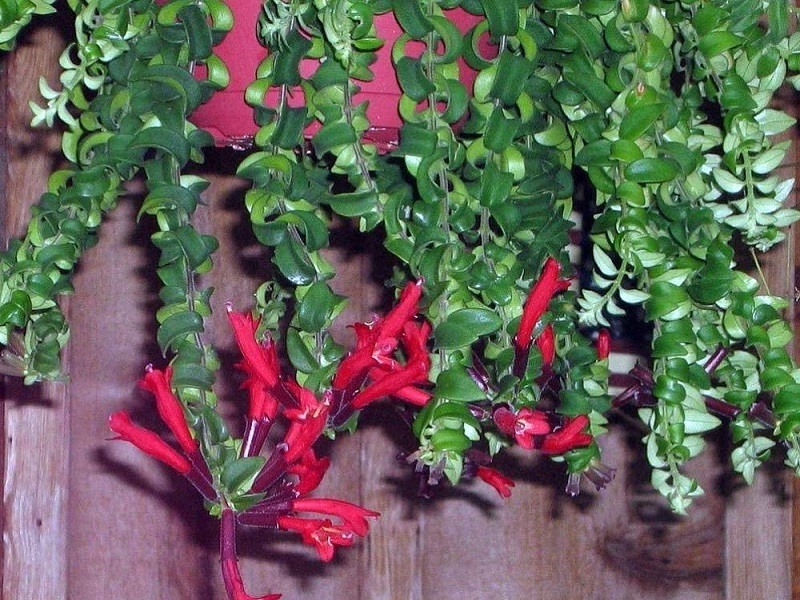I love growing flowering plants since they help to brighten up my indoor space. The lipstick plant happens to be my favorite indoor flowering plant. Thanks to its vivid red blossoms that emerge from maroon buds.
Lipstick plant care involves the provision of bright indirect sunlight, moderate soil moisture, fertile soil that drains well, high humidity, and maintaining a temperature range of 75-85oF. Be sure to feed the plant every two weeks during spring and summer.
Keep reading this comprehensive guide to learn how to care for a black pagoda lipstick plant like a professional. The most exciting thing is that aeschynanthus radicans are super easy to grow and maintain at home.

What Does a Lipstick Plant Looks Like?
The botanical name for the lipstick plant is aeschynanthus radicans. This striking evergreen tropical houseplant creates a lasting impression in any indoor space.
The vibrant red and tubular flowers that emerge from the burgundy buds are the reasons behind the lipstick plant name. These flowers occur in clusters along with waxy and glossy green foliages.
The cascading vine-like growth habit makes these tropical houseplants ideal for hanging baskets or tall planters (Check the Best Deals on Amazon).
These tropical flowering plants hail from Southeast Asia. The epiphytic nature allows the plants to grow on trees and in rock cracks.
Appropriate growing condition enables the tropical houseplant to reach two feet long or even more. The waxy and glossy leaves bring a little bit of jungle feeling to a home.
Growing lipstick plant is super easy to guarantee the production of beautiful flowers throughout the year. Below are the lipstick plant care tips to consider.
Lipstick Plant Care Details
| Origin | Java North and Malay Peninsula Rainforest |
| Botanical Name | Aeschynanthus radicans |
| Common Name | Lipstick Plant Lipstick Vine Basket Vine |
| Family | Gesneriaceae |
| Maximum Height | 3ft tall |
| Light Requirement | Bright indirect sunlight. Low light inhibits flower formation. |
| Watering Frequency | Slightly moist soil that never gets soggy. Overwatering causes root rot and other fungal conditions. |
| Soil Requirement | Fertile and well-draining potting soil. It ensures roots aeration and better growth. |
| Humidity Requirement | High indoor humidity level. Should be above 40%. |
| Indoor Temperature Range | 75-85oF (24-29oC) |
| Fertilizer Application | Feed the plant every two weeks during spring and summer. Use a water-soluble houseplant fertilizer. |
| Pruning and Maintenance | Prune long stems to promote a bushy appearance. Sterilize the pruner before using it. |
| Re-potting | Re-pot the plant once the roots start to penetrate the drainage holes. |
| Propagation | Stem cuttings |
| Pests and Diseases | Pests: Aphids, mealybugs, spider mites Diseases: Botrytis blight and root rot |
| Toxicity | Non-toxic to cats, dogs, and horses |
How to Care for a Lipstick Plant (Aeschynanthus Radicans)
Lipstick Plant Soil Requirements
Fertile and well-draining potting soil is an essential lipstick plant care tip. But these plants thrive on branches, rock crevices, and other plants in their native habitat.
Lipstick plants are more vulnerable to root rot when grown in a damp environment. Avoid heavy and compact soil since it holds more moisture for an extended period.
I recommend a mixture of equal parts of potting soil, peat moss, and perlite. Add compost to the soil mixture to increase its fertility. (Check the Best Potting Soil on Amazon).
Peat moss ensures the roots remain moist, and perlite promotes proper drainage. Another excellent option is to grow the lipstick plant on a wood board.
Lipstick Plant Light Requirements
The Aeschynanthus lipstick vine does best in bright indirect sunlight. Adequate natural light allows this tropical houseplant to bloom.
Keep lipstick plants away from direct sunlight to prevent leaves scorching issues. The high-intensity sunlight rays tend to ruin its general appearance.
You can place your houseplant under direct sunlight during the early morning or late evening. It is the period when the sunlight rays cannot harm your tropical houseplant.
Low light condition not only inhibits flower formation but also promotes stunted growth and leggy stems. It also increases the risk of lipstick plant leaves turning yellow.
Lipstick Plant Watering Frequency
The basket vines thrive in consistently moist soil. Too much water and sogginess increase the risk of root rot, leaf drop, and fungal issues.
Moderate watering frequency is the best for lipstick vines. Be sure to inspect the 2-3 inches of topsoil before watering your favorite houseplant.
Water the tropical houseplant once a week during spring and summer. Reduce the watering rate during fall and winter since the plant requires less soil moisture.
Soak the potting mix until excess water drains through the bottom drainage holes. Develop a strict watering schedule to avoid issues related to overwatering and under-watering.
Temperature Range for Lipstick Plant
The ideal indoor temperature range for lipstick vine is 75-85oF (24-29oC). It promotes the best growth and flowering. Lipstick vines can tolerate temperatures below 60oF but will slow growth.
The lipstick vines will suffer from tissue damages under any temperature below 50oF. Ensure the location of your houseplant is consistently warm to avoid temperature-related issues.
The best option is to use a digital thermometer (Check Best Deals on Amazon) to help detect and monitor indoor temperature changes. Keep your tropical plant away from cold and hot drafts.
Humidity Requirements for Lipstick Plant
Lipstick vines prefer a warm and humid environment to thrive. Replicate the high humidity level at home to foster the best growth.
Mist the lipstick plant leaves with room temperature water several times a day. Another excellent option is to install a humidifier to boost the humidity level in the house.
Ensure the lipstick plant receives bright indirect sunlight and adequate ventilation. The practice will help to avoid leaf-related problems due to indoor humidity fluctuation.
Low humidity will make your lipstick plant leaf tips and edges turn brown. Remember to keep the houseplant away from heating or cooling vents.
Fertilizer Requirement for Lipstick Plant
The lipstick plant is a light-feeder tropical plant. The incorporation of slow-release fertilizer in the potting mix will foster vegetative growth and deep-green foliages.
I recommend feeding your favorite tropical houseplant with a water-soluble fertilizer every two weeks during spring and summer. Stop feeding the plant in the winter due to dormancy issues.
Over-fertilization will cause lipstick plant leaves to turn brown. Be sure to flush the potting soil with distilled water to get rid of salt toxicity.
The golden rule is to flush the potting soil every three months to avoid excessive salt buildup. I also recommend the use of homemade fertilizer over artificial counterparts.
It would be best to read my article on How to Make Homemade Fertilizer for Houseplants. Most organic fertilizers do not pose any harm due to over-fertilization.
Lipstick Plant Pruning and Maintenance
Lipstick vines require an ultimate pruning routine to promote a bushier appearance. The practice also helps to get rid of leggy stems and avoid a straggly appearance.
I recommend pruning this tropical houseplant at the end of the blooming season. Pruning promotes the formation of flowers at the leaf tips.
Use a sharp hand pruner (Check Best Deals on Amazon) to perform the task. Remember to cut the leggy stems right above the leaf node.
Wipe the hand pruner with alcohol to avoid spreading potential plant diseases. Most of these conditions can be lethal to your lipstick vine.
How to Repot Lipstick Plant
I recommend re-potting the aeschynanthus lipstick vine after overgrowing the current hanging basket and the roots filling the bottom of the pot.
Use a container slightly larger than the current one. Be sure to re-pot this tropical houseplant during springtime or early summer. It is when the lipstick plants experience active growth.
Below are steps for re-potting lipstick plants:
- Fill the container with light and well-draining soil up to a quarter full.
- Make sure the container has drainage holes at the bottom. Water the potting soil to settle.
- Remove the lipstick plant from the current pot and inspect the root.
- Place the lipstick vine in the new container and add potting soil up to three quarters.
- Soak the potting mix again until excess water drains through the drainage holes.
Lipstick Plant Propagation
Stem cuttings are the best method for aeschynanthus lipstick vine propagation. Prune a stem of about 4-6 inches long from a mature houseplant.
Fill a new container with fertile and well-draining soil. Place the cut end of the lipstick plant in about a 1.5-inch hole and firm it with soil.
Water the soil and place the new pot in a location that receives bright indirect sunlight. It will take about six weeks for the lipstick stem cutting to develop roots.
Common Problems and Solutions
Pests
Lipstick plants are more vulnerable to several pests. It would be best to inspect the leaves every weekend to spot pest infestations at early stages.
These sap-sucking insects attack the leaf undersides of lipstick plants. It causes the leaves to curl and turn yellow or brown in the long run.
Aphids, spider mites, and mealybugs are the leading pests on lipstick vines. Use neem oil or horticultural soap to get rid of them.
Diseases
The indoor lipstick plants are more susceptible to botrytis blight. This fungal condition causes black spots and lesions on leaves or the entire plant.
The fungal disease occurs when the night-time temperature drops and the daytime is warm. The condition is more prevalent in winter and under high humidity.
Reduce the amount of moisture around the plant and provide proper ventilation to avoid fungal disease. Spray the foliages with copper fungicide in severe cases.
It would be best to read my article on Black Spots on Houseplant and How to Fix Them. The information will help you prevent these black spots and lesions on your lipstick vines.
Frequently Asked Questions
Why Are My Lipstick Plant Leaves Fall Off?
Improper soil moisture and cool temperatures are the leading cause of lipstick plant leave falling off. Keep your favorite tropical houseplant in a warm location and avoid cold drafts.
Learn to maintain consistent soil moisture that never gets soggy. It is the best practice to avoid leaves dropping from lipstick vine.
Is Lipstick Plant Poisonous to Cats and Dogs?
No. The Lipstick plant is non-toxic to pets and humans. But it would be best to keep your tropical plant away from pets and toddlers to avoid destruction.
Why Do My Lipstick Plant Leaves Have Black Spots?
Botrytis blight is the leading cause of black spots and lesions on lipstick vine leaves or stems. The fungal disease is due to poor ventilation, high humidity, and warm temperatures.
Isolate this tropical plant from your other indoor plant collection to combat the spread. Use a copper fungicide to treat the condition. Provide adequate ventilation and reduce the humidity level.
Why Does My Lipstick Plant Have Wrinkled Leaves?
Wrinkled leaves on lipstick plants are a sign of under-watering. Soak the potting soil until the excess water runs through the drainage holes.
Rehydration is the best lipstick plant care that helps to revive wrinkled leaves. Ensure the potting mix does not get soggy in the long run.

Final Thoughts
The lipstick plant is ideal for hanging baskets, wall sconces, and even attached to driftwood. The location allows this tropical houseplant to display its thick foliages, trailing vines, and beautiful flowers.
These evergreen plants grow as epiphytes in their native habitat. Variegated lipstick plant is the most popular aeschynanthus varieties due to its white or creamy leaf variegation and red blossoms.
You can find different types of lipstick plants on sale online for both indoor and outdoor. (Check the Best Deals for Lipstick Plants on Amazon).
I hope this comprehensive guide on how to care for a lipstick plant was helpful. Please feel free to share with other houseplant enthusiasts in your circle.